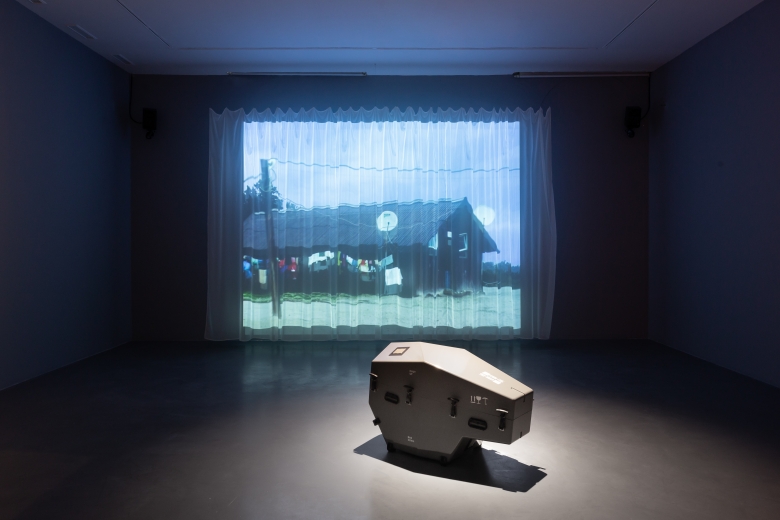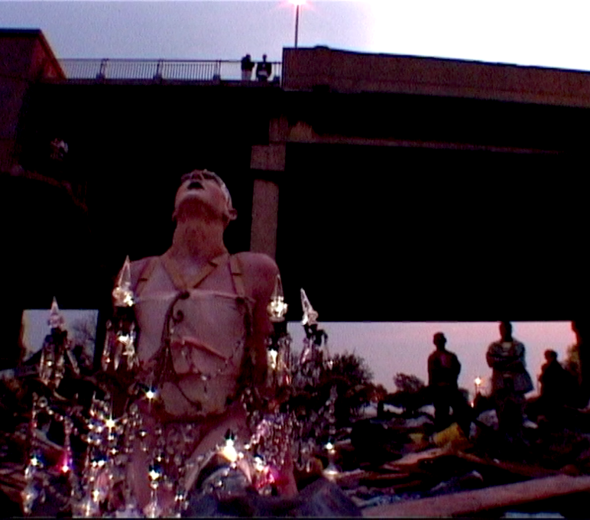
L’HEURE ENTRE CHIEN ET LOUP
Film programme from the Antoine de Galbert Collection
Selected by Isabel Nogueira
“L’heure entre chien et loup” marks the moment of all possibilities when it is not yet night or not yet day. It is all a matter of perspective. Light is specific and enveloping. As part of the exhibition Traverser la nuit, curated by Noëlig Le Roux, and included in the Portugal–France Season 2022, a set of works in video from the Antoine de Galbert collection was selected. These are suggestions that explore different aesthetics, issues and domains, such as politics, landscape contemplation, metaphor and war. For about an hour, we are invited to enter into this universe, sometimes dense, other times poetic and light. Just like when day gives way to night.
Programme
17.00–17.30 Open conversation with Noëlig Le Roux, Isabel Nogueira and João Pinharanda
17.30–18.30 Screening of films from the Antoine de Galbert Collection
Steven Cohen
The Chandelier Project, 2002, 16 min 18 s
An artist, dancer and performer, Steven Cohen (South Africa, 1962) has turned his body into a work of art that he subjects to all sorts of tests. Through provocative performances, he recounts his experiences as a white, Jewish and gay man in South Africa. The Chandelier Project is a 2002 performance in a Johannesburg township that is being demolished, where the artist walks around wearing a chandelier and high heels.
Pilar Albarracín
Lunares, 2004, 1 min 31 s
In her works, the Sevillian artist Pilar Albarracín (Spain, 1968) questions the standards of cultural identity, diverting the traditional codes of Andalusian culture such as bullfighting, dancing, singing, popular festivals, etc. In Lunares, the artist, dressed in a white dress, dances and pricks herself several times, establishing a link between flamenco and bullfighting. The dress is adorned with blood-red polka dots, a typical flamenco costume motif.
Ramuntcho Matta
m comme médiocre [m as in mediocre], 2007, 31 min
After starting his career in music at the end of the 1970s, Ramuntcho Matta (France, 1960) used the visual arts to give form to more singular and complex questions and creative subjects, using multiple media such as sound, drawing and video. m comme médiocre is from the series ABCD’air, Artistes de A à Z [ABCD'air, Artists from A to Z]. In this parody of a music video, he films a work by Jeff Koons in Venice.
Jean-Charles Hue
SS in Uruguay, 2001, 2 min 37 s
Jean-Charles Hue (France, 1968) is known for his numerous videos (short and feature-length) in which he films the members of a Yenish family, the Dorkels, with whom he shares moments of life. His works are inspired by his personal history: the artist comes from the gypsy community and his grandfather lived through the Shoah. As can be seen in SS in Uruguay, the camera is placed from the point of view of someone observing the scene - at first, a couple. One can assume that the old man is a former Nazi on the run and the woman is his nurse. The camera then moves away from the couple and focuses on the head of a chicken. This shot is not unimportant, since in gypsy culture this sign promises death.
Adam Vackar
Slap, 2007, 1 min 50 s
In his video, photography and installation work, Adam Vackar (Czech Republic, 1979) constantly mixes different languages and forms. These forms, which may seem absurd or even paradoxical, are always derived from experiences rooted in reality, made by the artist or by another person. Slap shows Adam Vackar's face, in close-up, being slapped. The effect of the blow triggers a cloud of white powder to fly off, covering the artist's face.
Barthélémy Toguo
The Thirsty Gardener, 2005, 2 min 49 s
Inspired by his travels and experiences, Barthélémy Toguo (Cameroon, 1967) is interested in flows: flows of goods, but also human flows and those who regulate them. Very attached to his native country, Cameroon, he has opened Bandjoun Station, an exhibition and residency venue to support African art. In The Thirsty Gardener, the viewer is invited to rethink the economy and its system through the artist's absurd gesture.
Pol Pierart
Autoportrait avec ma ville, 2005, 3 min 01 s
Le bonheur, le malheur, 2001, 10 min 6 s
Word games are very present in the work by Pol Pierart (Belgium, 1955).
It is the image-text relationship that interests the artist, such as in one of the first scenes of Autoportrait avec ma ville, where a sign hanging above the bed reads: “I'm not dead yet”.
In Le bonheur, le malheur, we can see a mixture of life scenes interspersed with shots where the artist, wearing a hood, delivers messages on signs.
The rest of the video is a sequence of shots of Liège. Pierart's videos, digitised here, were filmed in Super 8. The artist chose this technique not out of nostalgia, but because of the familiar, even familial, aspect of the format, its commonplace and non-prestigious character.
Geert Mul
Look at us, 2005, 5 min 10 s
For the past twenty years, Geert Mul (Netherlands, 1965) has been building up a collection of images and videos, taken from databases, which he then reuses. His works take the form of interactive videos or installations integrating sound and lighting. During a trip to Johannesburg, the artist left ten cameras with children from the streets of Hillbrow, asking them to film their surroundings. Of the fourteen hours of film recovered, two videos remain: Look at us and Dreamboy.
Tania Mouraud
La curée, 2004, 1 min 56 s
Born in 1942 in Paris, Tania Mouraud lives and works in Colombiers.
An artist who refuses to be attached to any particular movement, Tania Mouraud has been constantly developing her work since the end of the 1960s. Exploring alternately all sorts of disciplines - painting, installation, photography, performance, video, sound - she works constantly around one principle: to question the relationships between art and social links. La Curée shows dogs sharing a piece of meat, filmed in a close-up slow motion.
Lucien Pelen
Le villageois, 2010, 2'12"
A graduate of the Montpellier School of Fine Arts, Lucien Pelen (France, 1978) renews the traditional genre of landscape. Photographing or filming a wild and often grandiose nature, he prevents the spectator from indulging in pure aesthetic contemplation by placing interventions/performances in this framework in which he is the subject. Nature is merely the pictorial support for actions that mix the absurd with the poetic. He thus reverses the balance of power and, rather than showing man crushed by nature, reveals that a tiny silhouette is enough to disturb the balance of the immensity.
Mircea Cantor
Vertical Attempt, 2009, 1'04"
The work Mircea Cantor (Romania, 1977) is crossed by the notion of artifice. Through simple gestures and a great economy of means, he seeks to show the disruption of the world. Vertical Attempt is a one-second video, played on a loop, in which a child, sitting in front of a sink, cuts, with scissors, the trickle of water escaping from the tap. The action consists only of this impossible cut, a click that can be similar to the end or beginning of a film, confusing all notions of beginning or end in the loop.
